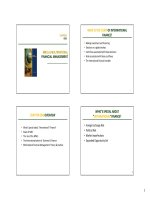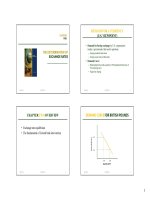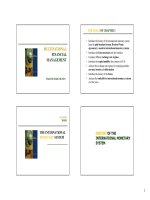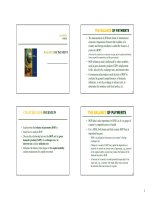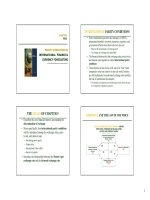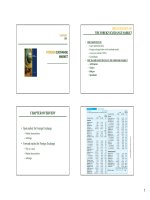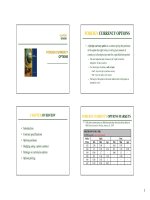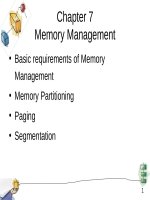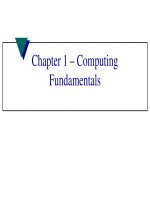Lecture Computing for management - Chapter 6
Bạn đang xem bản rút gọn của tài liệu. Xem và tải ngay bản đầy đủ của tài liệu tại đây (3.93 MB, 59 trang )
Business Data and
Information
Lecture 6
Summary of Previous
In the previous lecture we have learnt
What
are the quality metrics in order to buy a
monitor from a market.
Size, resolution etc.
Monitor
technologies
Strain due to wrongly choosing monitors.
How to avoid strain while using monitors.
Video cards and sound cards
Summary of Previous
We have seen a practical to set
the
resolution
DPI settings of monitors.
Today’s Topics
Data
Examples
of data and its types.
Number systems
Decimal
Binary
Number Systems
Bits and Bytes
How computer store data?
How computer represent data?
Today’s Topics
ASCII
EBCDIC
Unicode
Information
How
Data is Converted into Information?
Exercises
Knowledge
Data Sources
Today’s Topics
Direct
and Indirect Data Sources
Data Quality Matters
Microsoft Word Practical Session
What is Data?
Data items refer to an elementary
description of things, events, activities,
and transactions that are recorded,
classified, and stored but not organized to
convey any specific meaning.
Data items can be numbers, letters,
figures, sounds, or images.
Examples of Data Items
Examples of data items are
a student grade in a class, A+, A, B+, B-, etc
the number of hours an employee worked in
a certain week e.g. 50, 40, 60 etc.
Time e.g. 12:30
What are the Types of Data Items?
Types of Data are
Text
Multimedia
sound files, avi etc.
Numeric 0 1 2 3 4 5
Floating 10.23 2.4578 e 25 for scientific and
engineering purposes
Alpha Numeric A12, CIIT-Fall-001 etc.
Number System
Number Systems are used for,
Expressing
Numbers
A Manner of counting
Several different number systems exists.
Decimal number system
Used
by humans to count
Contains ten distinct digits
Digits combine to make larger numbers
How Computers Store Data?
As discussed in Lecture 1, a computer can
understand only 1 and 0.
A different number system is needed other
then decimal.
Hence it is a Binary Number System.
Binary number system
A number system that has just two
unique digits, 0 and 1
A
single digit is called a bit (binary digit)
A bit is the smallest unit of data the
computer can represent
By itself a bit is not very informative
The two digits represent the two off
and on states
OFFis ON orON
Bit
OFF
OFF
ON
OR
0
OR
= 1 bit
1
= 1 Byte
0
0
1
1
0
1
0
0
= 1 Byte
0
1
0
0
0
0
0
1
Byte –
Eight bits grouped together to represent a
character (an alphabetical letter, a number, or a
punctuation symbol); 256 different combinations.
Bits
1000 bits = 1 kilobit (kb)
1,000,000 bits = 1 megabit (mb)
1,000,000,000 bits = 1 gigabit (gb)
Kilobits per second (Kbps), megabits
per second (Mbps), and gigabits per
second (Gbps) are terms that describe
units of data used in measuring data
transfer rates.
•
Example: 56 Kbps modem
Bytes
8 bits = 1 Byte
1024 Bytes = 1 Kilobyte (KB)
1,048,576 Bytes = 1 Megabyte (MB)
1,043,741,824 Bytes = 1 Gigabyte (GB)
1,099,511,627,776 Bytes = 1 Terabyte (TB)
Kilobyte, megabyte, gigabyte, and
terabyte are terms that describe large
units of data used in measuring data
storage.
•
Example: 20 GB hard drive
How Computers Represent Data
In order to represent data, Text codes is
used by computer systems.
Used
to converts letters into binary
Standard codes necessary for data transfer
ASCII
Extended ASCII
American English symbols
Graphics and other symbols
Unicode
All languages on the planet
Representing Characters:
Character Codes
American
Standard
Code
Information Interchange (ASCII)
Eight
for
bits equals one character; used by
minicomputers and personal computers.
Character Codes
Extended
Binary
Coded
Interchange Code (EBCDIC)
Eight bits equals one
mainframe computers.
character;
Decimal
used
by
Character Codes
Unicode
– Sixteen bits equals one character;
over 65,000 combinations; used for language
symbols.
ASCII
=4
0
0
1
1
0
1
0
0
EBCDIC
=4
1
1
1
1
0
1
0
0
ASCII Table- Example
Character
Decimal
@
64
A
65
B
66
C
67
D
68
E
69
F
70
G
71
H
72
I
73
Detail of ASCII Table
Data Representation
How is a character sent from the keyboard to the
computer?
Step 1:
The user presses the letter T key
on the keyboard
Step 2:
An electronic signal for the letter
T is sent to the system unit
Step 3:
The signal for the letter T is
converted to its ASCII binary
code (01010100) and is stored in
memory for processing
Step 4:
After processing, the binary code
for the letter T is converted to an
image on the output device
What is Information?
Information refers to data that have been
organized so that they have meaning and value
to the recipient.
For
example, a grade point average (GPA) is data,
but a student’s name coupled with his or her GPA is
information.
The recipient interprets the meaning and draws
conclusions
and
implications
from
the
information.

